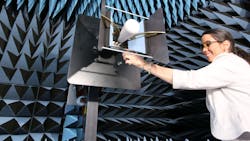DARPA hires three companies for blended RF system to reduce size and ease technology insertion aboard UAVs
ARLINGTON, Va. – U.S. military researchers are involving three RF and microwave technology companies in $23.2 million effort to develop a blended RF system that combines radar, electronic warfare (EW), and communications components aboard medium-sized unmanned aircraft.
Officials of the U.S. Defense Advanced Research Projects Agency (DARPA) in Arlington, Va., have awarded contracts over the past month to Perspecta Labs Inc. in Red Bank, N.J.; L-3 Mustang Technology Group in Plano, Texas; and the Northrop Grumman Corp. Mission Systems segment in Linthicum, Md. for phases 2 and 3 of the Converged Collaborative Elements For RF Task Operations (CONCERTO) program.
CONCERTO seeks to move away from collections of rigid and constrained RF systems to one converged approach that is scalable, agile, easily modified, facilitates technology insertion, and that makes the most of common RF apertures.
The program, moreover, will demonstrate this converged RF approach in an RF payload that fits aboard medium-sized unmanned aerial vehicles (UAVs) that weigh less than 1,320 pounds like the AAI RQ-7 Shadow, or the Boeing Insitu RQ-21 Blackjack.
Perspecta Labs won a potential $7.5 million contract on 10 May 2019; L-3 Mustang Technology won a potential $7.3 million contract on 10 May 2019; and Northrop Grumman won a potential $8.3 million contract on 10 June 2019 for integrating blended RF systems aboard medium-sized UAVs.
Dominance of the RF spectrum is critical to successful U.S. military operations, DARPA researchers explain. Today the military does this using discrete radar, EW, and communication payloads that are separately designed, procured, and integrated.
These payloads typically use dedicated apertures, have tightly coupled hardware and software, and are not well-coordinated in their use of the RF spectrum, which makes it difficult and time consuming to adopt new technology, adapt to rapidly changing threats, change RF functions quickly, and create compact RF systems.
Instead, the CONCERTO program is developing a modular architecture for adaptive, converged RF systems and using it for one converged RF payload that performs radar, EW, and communications.
Related: Advances in hybrid optical packaging enable high-bandwidth photonic RF transmission
CONCERTO systems could carry out multi-function operations in less space and power than the combined collections of discrete systems, increase the capability of small- and medium-sized UAVs, and speed technology insertion by decoupling hardware from software and firmware.
The three CONCERTO phase 2 and 3 companies are focusing on four technology areas: converge, abstract, control, and integrate in advanced efforts to design, integrate, control, and test a demonstration CONCERTO payload on a medium-size UAV.
Converge seeks to blend RF front end and aperture to create a scalable wideband RF front end that includes radiating apertures and airframe integration, antennas, converting RF to digital signals.
Abstract seeks to create a converged heterogeneous RF processing engine for RF control and signal processing in a portable, easily upgraded, hardware-agnostic RF virtual machine.
Related: Synthetic aperture radar technology key part of space-based radar
Control seeks to create a system and sensor resource manager to coordinate disparate RF jobs in the converged system. Integrate, meanwhile, seeks to carry out the CONCERTO system architecture, mission analysis, integration, and flight testing, leading to demonstration of a converged system architecture.
The three companies participated in the first phase of the CONCERTO project to develop promising technologies. Now they move to phases 2 and 3 where they will continue development, leading to flight tests. Collins Aerospace in Cedar Rapids, Iowa, and Vencore Labs Inc. in Basking Ridge, N.J., also were involved in the first phase of CONCERTO.
For more information contact Perspecta Labs online at www.perspectalabs.com; L-3 Mustang Technology at www2.l3t.com/mustangtechnology; Northrop Grumman Mission Systems at www.northropgrumman.com; or DARPA at www.darpa.mil.
About the Author
John Keller
Editor-in-Chief
John Keller is the Editor-in-Chief, Military & Aerospace Electronics Magazine--provides extensive coverage and analysis of enabling electronics and optoelectronic technologies in military, space and commercial aviation applications. John has been a member of the Military & Aerospace Electronics staff since 1989 and chief editor since 1995.
